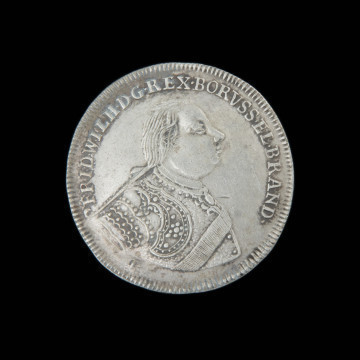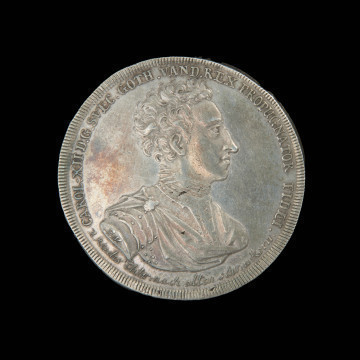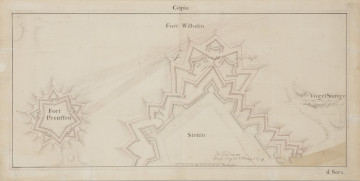
1/2 thaler on the occasion of the Szczecin tribute
1721
National Museum in Szczecin
Part of the collection: Pomeranian coins
In the second half of the 17th century, the wars between Brandenburg and Sweden resulted in Szczecin being sieged twice (1659 and 1677). The second siege lasted six months, and the population and city's buildings suffered considerable losses. After the victorious battle in 1677, the Elector of Brandenburg, Friedrich Wilhelm, ordered three types of commemorative stamps from an outstanding medal-maker from Gdańsk, Jan Höhn the Younger. In Berlin, they were used to strike half-ducats, double-ducats (two types and nine varieties) and the same stamps for prints in silver. The coins have the character of medal (manifestation) issues, which did not go into circulation but were intended for the winners as souvenirs. The obverse of the two-ducat prints shows the bust of the victorious Friedrich Wilhelm wearing a laurel wreath. The CS letters below the bust belong to the Berlin bard (assayer) Christoph Stricker. The Elector's claim to the whole of Pomerania is clearly emphasised by the Pomeranian title: FRID WILH EL STETIN POM DVX (Frederick William Elector, Duke of Szczecin-Pomerania). The apotheosis of the ruler in the form of glorifying representation is reflected in the composition on the reverse. Above the panorama of Szczecin from the south, i.e., from the side of the main attack, there is a highly original depiction of three heraldic elements: an eagle, a sceptre and a griffin. The eagle (symbol of Brandenburg) and the griffin (symbol of Pomerania) hold the Elector's sceptre. The triumphal motto in the half-circle completes the glory: FORTIOR HIS SIGNIS (stronger under this sign). It is worth mentioning that the ordering of coins and medals from the famous artist Jan Höhn the Younger was a guarantee of interesting compositions and excellent work on details. Unfortunately, on the museum copy, one can see the difference in the elaboration. The carelessness of the quality and the simplified panorama of the city suggest that another engraver made the stamp. The work was created based on the same engraving, but it varies enormously in artistic terms. In a situation where Höhn signed part of the issue (five varieties of stamps), the lack of his initials on the presented copy only confirms this conjecture.
Genowefa Horoszko
Author / creator
Dimensions
cały obiekt: height: 1.0, diameter: 29.4 mm
Object type
commemorative coin
Technique
minting
Material
silver
Creation time / dating
Creation / finding place
Owner
National Museum in Szczecin
Identification number
Location / status

1721
National Museum in Szczecin

1709
National Museum in Szczecin

1734-03-07
National Museum in Szczecin
DISCOVER this TOPIC
Museum of King Jan III's Palace at Wilanów
DISCOVER this PATH
Educational path